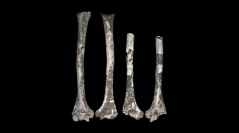

 Comptes Rendus Palevol
17 (8) - Pages 616-627
Comptes Rendus Palevol
17 (8) - Pages 616-627The Upper Paleolithic (Early Epipaleolithic/Kebaran; ∼ 19,000 cal BP) human skeleton, from Layer 3 of Ein Gev I on the western flanks of the Golan Heights adjacent to the Sea of Galilee, retains sufficient limb remains to permit assessment of its body size and proportions, as well as diaphyseal reflections of skeletal hypertrophy. The individual was of modest stature but average mass for a later Upper Paleolithic individual, providing it with the body mass-to-stature body proportions characteristic of later Upper Paleolithic and more recent circum-Mediterranean humans. The humeri exhibit unexceptional diaphyseal asymmetry and robustness for an Upper Paleolithic human, and the femur exhibits similar relative diaphyseal hypertrophy. The humeral midshafts are relatively round, but the femoral and tibial midshafts are pronounced anteroposteriorly. As such, Ein Gev 1 provides additional paleobiological data on the appendicular remains of these Southwest Asian humans prior to the increasing sedentism of the terminal Pleistocene.
Human paleontology, Humerus, Femur, Upper Paleolithic